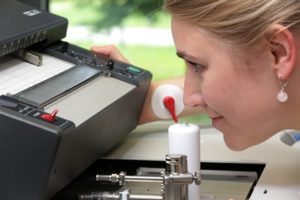It is a known fact that adhesives may smell unpleasant. However, as Fraunhofer researchers have recently discovered, this doesn’t need to be the case. Through extensive research on acrylic adhesives they were able to identify the substances responsible for the offensive odors. So far, very little research has been conducted on the subject, but now manufacturers finally have the opportunity to optimize their production process.

© Photo Fraunhofer IVV
The researchers in Freising rely on a variety of analysis methods, including gas chromatography, to detect the causes of unpleasant odors in acrylic adhesives.
Nowadays almost all products feature adhesives – for example, they are found in windshields, cell phone displays, shoes, carpets, plasters or physio tapes. Some adhesives contain solvents that smell unpleasant. However, solvent-free products or those with a low concentration of solvents can also emit a pungent odor. There is as yet very little known about which substances cause the stench and how they affect the human body. The Department of Sensory Analytics at the Fraunhofer Institute for Process Engineering and Packaging IVV is committed to researching this issue. Among other things, Prof. Andrea Buettner and her team have tested four solvent-free acrylic adhesives to find out which components trigger the offensive odors. They published their research findings in the International Journal of Adhesion and Adhesives.
Indication of hazardous substances
In their analyses, the researchers were able to identify 27 odorants that were causing the unpleasant smells. These include methyl methacrylate, acetophenone, 1-butanol, 4-methylphenol, phenylacetic acid methyl ester and acetic acid. It was the first time that 20 substances, including the chemical compound borneol, were identified as odor-active compounds in adhesives. This variety of substances was matched by the breadth of odor impressions, which ranged from pungent, fruity and leathery to smoky and moldy. “If a product emits a particularly strong odor, this can indicate the presence of hazardous substances,” says Prof. Büttner. Some of the samples contained phenolic compounds suspected of being mutagenic. Prof. Büttner, who is the department head and deputy director of Fraunhofer IVV, sees a clear need for action to optimize the product development of adhesives. “Our analysis shows that a series of substances we found ought to be eliminated, and not just in terms of odor emissions. Strong odors can most definitely cause headaches and dizziness. We should be asking why adhesives smell. The mindset of both the user and the manufacturer needs to change in this regard.”
Scientists at Fraunhofer offer manufacturers solutions and targeted strategies to improve adhesives and other everyday non-food products – including paints, binders, furniture, softeners, detergents and plastics – from the point of view of the odorants they contain. “We’ve set ourselves the task of supporting manufacturers in product development, as the methods they employ mean they are often not in a position to know which of the components are causing the odors. This requires special analysis as well as trained test subjects to detect triggers, possible impurities and byproducts arising during the manufacturing process,” emphasizes the food chemist. In addition, the results of the research conducted by the scientist and her colleagues provide the basis for psychological and toxicological evaluations of hazardous substances.
For their analyses, the researchers rely on different methods and devices, such as gas chromatography and mass spectrometry; these enable them to carry out simulated exposure studies in real-life situations to detect and quantify the substances being emitted. In other words, the researchers determine how much is being emitted in normal use. In short: the analytical requirements are high. The detection methods must cover as broad a spectrum of chemical substances as possible, since odorants are not a chemically uniform group. Their only commonality is that they are volatile. In addition, the analysis must differentiate between odor-active and -inactive substances. Machine detectors are only partly capable of achieving this, which is why the human nose is still irreplaceable. It is also the reason why sensory tests are conducted at the start of the analysis.
Follow your nose
Weekly sensory training sessions are held at Fraunhofer IVV to train test subjects on becoming odor experts. The test subjects are given samples in odorless glass containers. The sensor panel sets characteristic odor attributes for each sample; in a second sensory session, it evaluates them against reference compounds on a predetermined scale. The overall intensity and the personal preference or dislike of an odor impression is then evaluated, with the mean values of the evaluations being used to summarize an odor profile. The expert on adhesive materials is Philipp Denk, a colleague of Prof. Büttner based in Freising. He researches all types of adhesive components – for example in food packaging and the medical sector. His current focus is the acrylic adhesive group, following which he will analyze physio tapes, some of which also contain odor-intensive compounds. “A globalized market and an ever-growing e-commerce sector is a major challenge for the official testing authorities – regarding the wide range of products they must test for hazardous components. That’s why we’re developing new technologies in order to support quality control and official entities and allow decentralization of the testing of products for hazardous substances.”